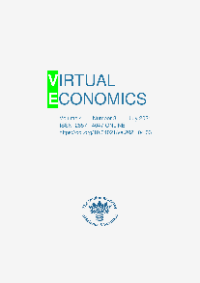The Strategies of Internalizing the Negative Externalities in the Company’s Sustainable Development
DOI:
https://doi.org/10.34021/ve.2021.04.03(1)Keywords:
positive externality; negative externality; internalization of externalities; sustainable development; analysis of externality of the company; defensive strategies; offensive strategiesAbstract
The study focuses on externalities which play the important role in sustainable development. They indicate the impact of the company’s activity on the third persons. On the basis of findings, the externalities from the company’s financial reports are monetarized. The externalities exerting influence on the profit or loss as well as on the total balance of the company are analysed. Positive and negative externalities are identified in order to internalize the negative externalities with the help of definite strategies of sustainable development. It is emphasized that the long-term action plans to ensure competitiveness, environmental protection and social legitimacy help to adapt to expected market, environmental and social developments. The study discusses current strategies: defensive (reactive), offensive that are viewed from the economic, environmental and social perspective. It is investigated that the defensive strategies are limited to the implementation of relevant laws or agreements in order to avoid negative consequences for the legislator. On the other hand, offensive, inward-looking strategies are aimed at aligning the company’s structures (organizations) and systems (environmental management systems) with the requirements of sustainable development, motivation and qualification of employees for sustainable development. The environmental sustainable development strategies are focused on a variety of ecological aspects. The emergence of economic, environmental and social risks and opportunities in machine-building company with their potential solutions is underlined. As the matter of fact, using the right strategy, the company can easily go through the internalization of negative externality to exert more substantial impact on the society, environment and the economy.
Downloads
References
van den Bergh, J.C.J.M. (2007). Sustainable development in ecological economics. Chapter 4. In G. Atkinson, S. Dietz, & E. Neumayer (Eds.), Handbook of Sustainable Development, (pp. 63-77). Cheltenham, UK: Edward Elgar Publishing.
Bithas, K. (2011). Sustainability and externalities: Is the internalization of externalities a sufficient condition for sustainability?. Ecological Economics, 70, 1703-1706.
Clark, J. M. (1917). Business Acceleration and the Law of Demand: A. Technical Factor in Economic Cycles. Journal of Political Economy, XXV, 217-335.
Coase, R. H. (1937). The Nature of the Firm. Economica, 4(16), 386-405.
Common, M. (2011). The relationship between externality, and its correction, and sustainability. Ecological Economics, 70(3), 453. https://doi.org/10.1016/j.ecolecon.2010.10.009
Commons, J. R. (1959). Institutional economics; its place in political economy. Madison: University of Wisconsin Press.
Costanza, R. (1991). Ecological Economics: The Science and Management of Sustainability. New York: Columbia University Press.
Galbraith, J. K. (1973). Economics and the Public Purpose. Boston, US: Houghton Mifflin Company.
Global Risks Report. (2011). Retrieved from https://www.weforum.org/reports/global-risks-report-2011
Hicks, J. (1939). The foundations of welfare economics. Economic Journal, 196, 696-712.
JST SMNVO. (2020). Financial Reporting. Retrieved from http://snpo.ua/uk/pro-kompaniyu/dlya-aktsioneriv/finansova-zvitnist/.
JSC Nasosenergomash. (2020). Issuer information. Retrieved from https://nempump.com/uk/informatsiya-emitenta_/.
JSC Energomash. (2020). Issuer's information. Disclosure of information and reporting of the issuer. Retrieved from http://energomash.sumy.ua/S2/company/akcioner/index.php.
Kaldor, N. (1939). Welfare Propositions of economics and interpersonal comparisons of utility. Economic Journal, 195, 549-552.
Kepplinger, H.M. (2012). Bis zum Platzen. Der Tagesspiegel. 17. Juni.
Lukash, O., Derev’yanko, Y., Kozlov, D., & Mukorez, A. (2021). Regional Economic Development in the Context of the COVID-19 Pandemic and the Economic Crisis. Mechanism of Economic Regulation, 1, 99–107.
Mitroff, I.I. (1994). Crisis Management and Environmentalism: A Natural Fit. California Management Review, 36, 101–113.
Musgrave, R.A. (1959). The Theory of Public Finance. N.-Y.: McGraw Hill.
North, D. (1983). Structure and Change in Economic History. The Economic Journal, 93(372), 963-965.
Paris Agreement. (2015). Retrieved from https://unfccc.int/process-and-meetings/the-paris-agreement/the-paris-agreement
Papandreou, A. A. (2003). Externality, convexity and institutions. Economics and Philosophy, 19, 281-309.
Pareto, V. (1927). Manuel d‘economie politique. Paris: Marcel Giard.
Pigou, A.C. (1952). Economics of Welfare. Third Ed. London, UK: Macmillan.
PJSC SPJSC Vndikompressormash. (2020). Retrieved from http://old.vnii.com.ua/content/dokumenty
Porter, M.E., & Kramer, M.R. (2006). Strategy & Society. Harvard Business Review, 84(12), 78-92.
Samuelson, P. A. (1948). Economics: An Introductory Analysis. New York: McGraw-Hill Company.
Staehle, W.H., & Nork, M.E. (1992). Umweltschutz und Theorie der Unternehmung. München: Handbuch des Umweltmanagements.
United Nations Conference on Sustainable Development, Rio+20. (2012). Retrieved from http://www.uncsd2012.org/about.html.
Varian, H. R. (1992). Microeconomic Analysis. New York: Norton.
Wagner, G.R., & Janzen, H. (1994). Umwelt-Auditing als Teil des Betrieblichen Umwelt- und Risikomanagements. Betriebswirtschaftliche Forschung und Praxis, 46, 573–604.





